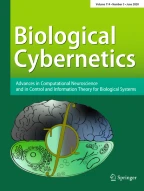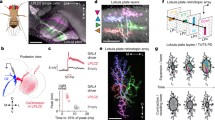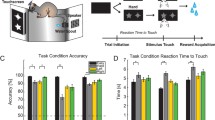Abstract
A new class of large-field tangential neurones (Figure Detection (FD-) cells) has been found and analysed in the lobula plate, the posterior part of the third visual ganglion, of the fly by combined extra-and intracellular recording as well as Lucifer Yellow injection. The FD-cells are likely to play a prominent role in figure-ground discrimination. Together with the Horizontal Cells, the output elements of the neuronal network underlying the optomotor course control reaction, they seem to be appropriate to account for the characteristic yaw torque response to relative motion. The FD-cells might thus compensate for the “deficits” of the Horizontal Cells with respect to figureground discrimination (see Egelhaaf, 1985a).
The FD-cells are directionally selective for either front-to-back (FD 1, FD 4) or back-to-front motion (FD 2, FD 3). Their excitatory receptive fields cover part of (FD 1, FD 2, FD 3) or the entire horizontal extent (FD 4) of the visual field of one eye. Their most important common property in the context of figureground discrimination is that they are more sensitive to relatively small objects than to spatially extended patterns. Their response to a small figure is much reduced by simultaneous large-field motion in front of the ipsi-as well as the contralateral eye. This large-field inhibition is either directionally selective or bidirectional, depending on the FD-cell under consideration. The main dendritic arborization of all FD-cells resides in the lobula plate. Their axonal projections lie in either the ipsi-or contralateral posterior optic foci and, thus, in the same area as the terminals of the Horizontal Cells. The FD-cells are, therefore, appropriate candidates for output elements of the optic lobes involved in figure-ground discrimination.
Article PDF
Similar content being viewed by others
Avoid common mistakes on your manuscript.
References
Beersma, D.G.M., Stavenga, D.G., Kuiper, J.W.: Retinal lattice, visual field and binocularities in flies. J. Comp. Physiol. 119, 207–220 (1977)
Bridgeman, B.: Visual receptive fields sensitive to absolute and relative motion during tracking. Science 178, 1106–1108 (1972)
Collett, T.S.: Visual neurones for tracking moving targets. Nature 232, 127–130 (1971)
Collett, T.S.: Visual neurones in the anterior optic tract of the pivet hawk moth. J. Comp. Physiol. 78, 396–433 (1972)
Collett, T.S., King, A.J.: Vision during flight. In: The compound eye and vision of insects. pp. 437–466. Horridge, G.A., ed. Oxford: Clarendon Press 1975
Egelhaaf, M.: On the neuronal basis of figure-ground discrimination by relative motion in the visual system of the fly. Part I: Behavioural constraints imposed on the neuronal network and the role of the optomotor system. Biol. Cybern. (in press, 1985a)
Egelhaaf, M.: On the neuronal basis of figure-ground discrimination by relative motion in the visual system of the fly. Part III: Possible input, circuitries and behavioural significance of the FD-cells. Biol. Cybern. (in press, 1985b)
Frost, B.J., Nakayama, K.: Single visual neurons code opposing motion independent of direction. Science, 220, 744–745 (1983)
Frost, B.J., Scilley, P.L., Wong, S.C.P.: Moving background patterns reveal double-opponency of directionally specific pigeon tectal neurons. Exp. Brain Res. 43, 173–185 (1981)
Grünau, M. von, Frost, B.J.: Double-opponent-process mechanisms underlying RF-structure of directionally specific cells of cat lateral suprasylvian visual area. Exp. Brain Res. 49, 84–92 (1983)
Hammond, P., MacKay, D.M.: Modulatory influences of moving textured backgrounds on responsiveness of single cells in feline striate cortex. J. Physiol. 319, 431–442 (1981)
Hausen, K.: Monocular and binocular computation of motion in the lobula plate of the fly. Verh. Dtsch. Zool. Ges. 74, 49–70 (1981)
Hausen, K.: Motion sensitive interneurons in the optomotor system of the fly. I. The horizontal cells: Structure and signals. Biol. Cybern. 45, 143–156 (1982a)
Hausen, K.: Motion sensitive interneurons in the optomotor system of the fly. II. The horizontal cells: receptive field organization and response characteristics. Biol. Cybern. 46, 67–79 (1982b)
Hausen, K., Wehrhahn, C.: Microsurgical lesion of horizontal cells changes optomotor yaw responses in the blowfly Calliphora erythrocephala. Proc. R. Soc. Lond. B 219, 211–216 (1983)
Mandl, G.: Responses visual cells in cat superior colliculus to relative pattern movement. Vision Res. 25, 267–281 (1985)
Mason, R.: Responsiveness of cells in the cat's superior colliculus to textured visual stimuli. Exp. Brain Res. 37, 231–240 (1979)
Miezin, F., McGuinness, E., Allman, J.: Antagonistic direction specific mechanisms in area MT in the owl monkey. Soc. Neurosci. Abstr. 8, 681 (1982)
Olberg, R.M.: Object-and self-movement detectors in the ventral nerve cord of the dragonfly. J. Comp. Physiol. 141, 327–334 (1981)
O'Shea, M., Rowell, C.H.F.: Protection from habituation by lateral inhibition. Nature 254, 53–55 (1975)
Poggio, T., Reichardt, W., Hausen, K.: A neuronal circuitry for relative movement discrimination by the visual system of the fly. Naturwissenschaften 68, 443–446 (1981)
Reichardt, W.,Poggio, T.: Figure-ground discrimination by relative movement in the visual system of the fly. Part I. Experimental results. Biol. Cybern. 35, 81–100 (1979)
Reichardt, W., Poggio, T., Hausen, K.: Figure-ground discrimination by relative movement in the visual system of the fly. Part II: Towards the neuronal circuitry. Biol. Cybern. 46 [Suppl.] 1–30 (1983)
Rizzolatti, G., Camarda, R.: Influence of the presentation of remote visual stimuli on visual responses of the cat area 17 and lateral suprasylvian area. Exp. Brain Res. 29, 107–122 (1977)
Rowell, C.H.F., O'Shea, M., Williams, J.L.D.: The neuronal basis of a sensory analyser, the acridid movement detector system. IV. The preference for small field stimuli. J. Exp. Biol. 68, 157–185 (1977)
Sterling, R., Wickelgren, P.: Visual receptive fields in the superior colliculus of the cat. J. Neurophysiol. 32, 1–15 (1969)
Stewart, W.W.: Functional connections between cells as revealed by dye-coupling with a highly fluorescent naphthalimide tracer. Cell 14, 741–759 (1978)
Strausfeld, N.J., Bassemir, U., Singh, R.N., Bacon, J.P.: Organizational principles of outputs from dipteran brains. J. Insect Physiol. 30, 73–93 (1984)
Wehrhahn, C.: Visual guidance of flies during flight. In: Comprehensive insect physiology, biochemistry and pharmacology. pp. 673–683. Kerkut, G., Gilbert, L.,eds. Oxford: Pergamon Press 1985
Wehrhahn, C., Hausen, K., Zanker, J.: Is the landing response of the housefly (Musca) driven by motion of a flow field? Biol. Cybern. 41, 91–99 (1981)
Author information
Authors and Affiliations
Rights and permissions
About this article
Cite this article
Egelhaaf, M. On the neuronal basis of figure-ground discrimination by relative motion in the visual system of the fly. Biol. Cybern. 52, 195–209 (1985). https://doi.org/10.1007/BF00339948
Received:
Issue date:
DOI: https://doi.org/10.1007/BF00339948




